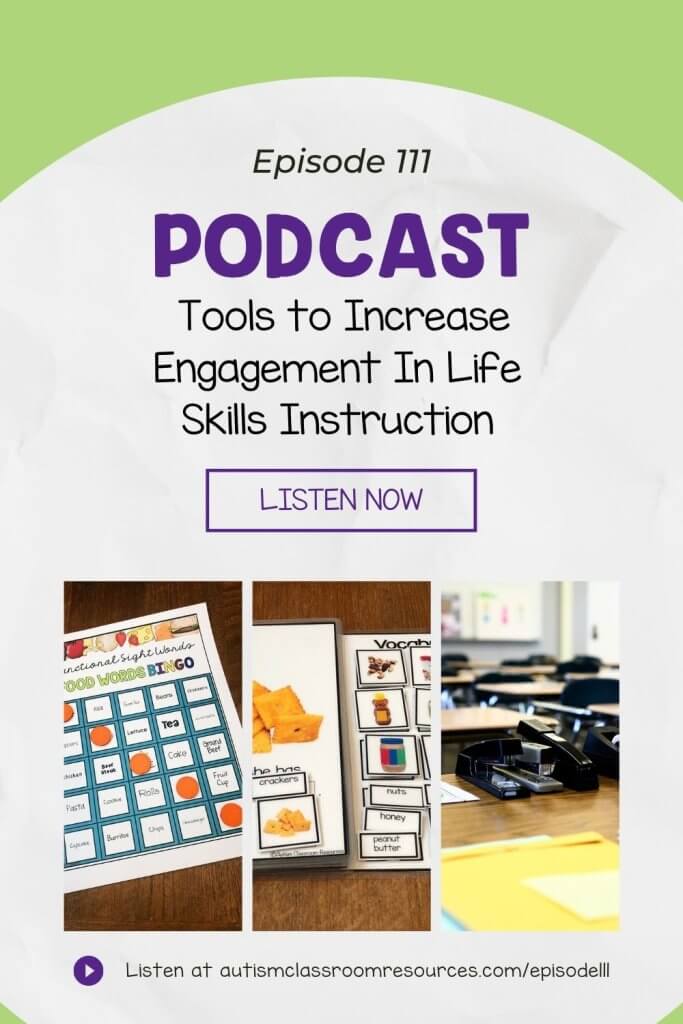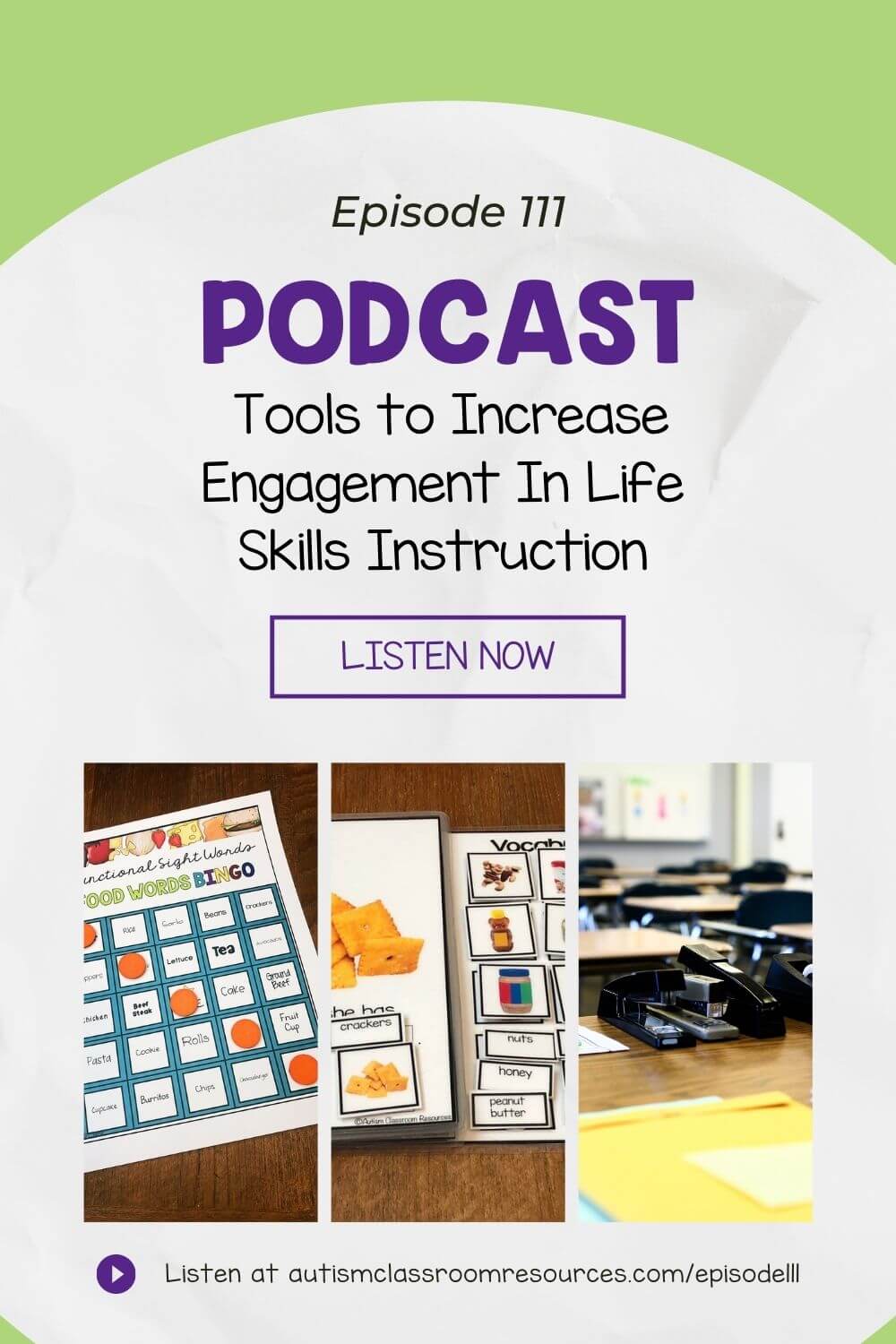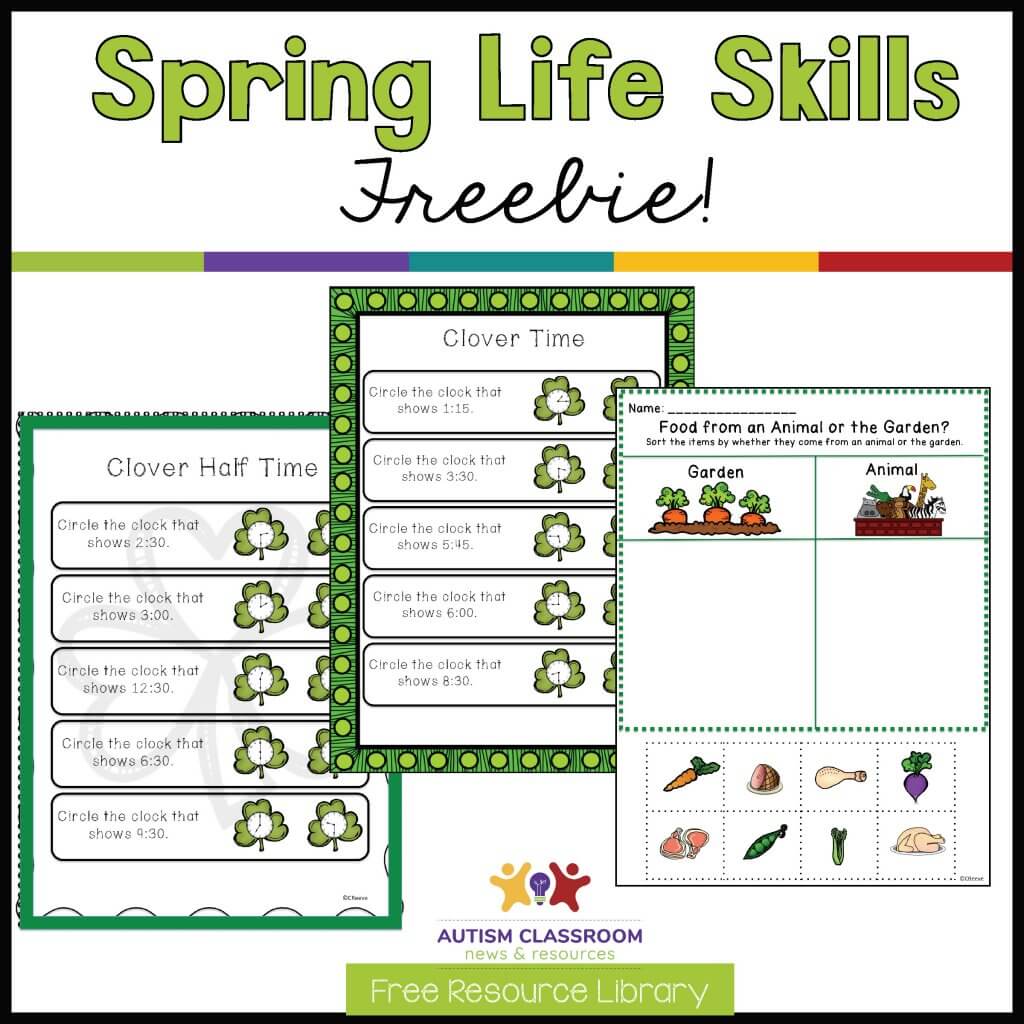Welcome to the Autism Classroom Resources Podcast, the podcast for special educators who are looking for personal and professional development.
Christine Reeve: I’m your host, Dr. Christine Reeve. For more than 20 years, I’ve worn lots of hats in special education but my real love is helping special educators like you. This podcast will give you tips and ways to implement research-based practices in a practical way in your classroom to make your job easier and more effective.
Welcome back to the Autism Classroom Resources Podcast. I am Christine Reeve and I’m your host. I love teaching life skills. I think I mentioned in one of my previous podcasts that I have a sister who’s on the autism spectrum and has other developmental disabilities, but went through school in general education with few people understanding that she had a disability. She graduated from high school. She went on to get an associate’s degree in accounting all without any extra help, but she really struggled when living independently to do things like maintaining a budget. She got through high school and her two-year degree primarily by memorization. She had an amazing memory for everything.
When I was a teenager and we got our first computer—which most of you would so not recognize, even recognize as being a computer because I had to learn how to program it in order to make it work—she was working in my family’s very small business, and I always find it ironic that one of her jobs was to balance their books, which she did quite well. But she struggled to go to the grocery store without having difficulty at the cashier with not having enough money to buy her groceries. Her learning style became super apparent to me though when my parents asked me to train her in how to use the computer for accounting. I realized after much frustration that she was basically just memorizing the key sequences. If she missed one, everything was lost because she couldn’t correct the error. If there was a need to make a change for some reason, she couldn’t problem-solve it because she only knew the steps, not why she was doing them. She couldn’t generalize her knowledge from the rote information to the function of what she was doing.
As I look back, I think this is one of the reasons why life skills instruction has such a strong focus in all of my work. My sister has independent living skills only because my parents taught them to her, and that was only because my mother had the skills to teach as a teacher. She generalized the skills that she had to the community only because my mother and I—since she’s 13 years older than I am, got to go with them—took her into the community and practiced with her over and over, and over and over. Why am I telling you this? Because today’s episode is about ways to get your students engaged in life skills instruction. But it’s also about varying your instruction of life skills so that your students generalize their skills. Switching up your instructional strategies is a way to keep the students engaged with them but it also serves to expose them to new ways of using the skills which makes it more likely that they will generalize those skills to new settings and situations. That makes it more likely that they’ll maintain them and that they’ll be used once they leave your classroom.
Today, I’m going to talk about different ways to work on life skills and I’m going to choose functional literacy as an example to carry through four different kinds of activities that you can use for this. Plus, I’ve got a free resource for you to help you work on life skills within your classroom that I’ll share at the end of the episode, and if you’re looking for tons of teacher ideas for life skills classrooms and how to set them up, we have a number of workshops and quick wins set up specifically for this kind of classroom in the Special Educator Academy. The academy is a great place to learn effective teaching strategies, tools, and ideas to help you make your job easier every day. It doesn’t require a big time commitment to make a change in your day either. Come check out a seven-day free trial at specialeducatoracademy.com. Now let’s get started.
I’m going to use functional literacy and functional reading as an example to make this easier to talk about in a podcast. Let’s say that you are teaching functional sight words around grocery and other food words. I have a curriculum on this set up, so that’s one of the reasons I’m using it as an example, is because it’s just easier for me to pull from that kind of material. I’ll put a link to that in the show notes. You might teach them at first in a discrete trial type of situation or explicit instruction. For instance, in your reading center to start, and that’s a good way to introduce them. But we know, especially with reading, that we need our students to encounter print in a variety of forms. We know that in order to really build functional literacy and true reading skills, we need reading comprehension, reading fluency, reading in the real world, and reading with connected text.
The next step might be to introduce the words in books. Now, I like using interactive books with students with disabilities because they keep our students who typically are working on life skills actively engaged in reading. It can sometimes be a challenge to find books that are written at their reading level that contain these functional kinds of words. In this curriculum set that I’m talking about today, I have a set of interactive books that are focused around food words, so they’re all about stories about adolescents and adults going to restaurants, cooking, or going to the grocery store, and things like that. They’re all about using food at home in the community. You could also find or make interactive books, but you can also find other books at places like Tar Heel Reader. If you’re not familiar with Tar Heel Reader, definitely go check it out at tarheelreader.org, and I’ll make sure that’s in the show notes too. Or you could also have your students find the words in grocery store flyers, in the online grocery store on the computer or tablet, or in cooking magazines.
You can have them match them to pictures in those places and in books as well. By using a variety of materials, the students get used to seeing the words in different prints and using them in different ways. They start to match the different pictures and for different purposes. You’d start to see some of that comprehension and that generalization. A second way that you might engage them, which they may not realize is even a reading activity, is to play Sight Words Bingo. I included a set of Sight Words Bingo in that functional word series curriculum set, but you could use lotto games or make your own. The key is to find the level that meets the needs of your students, and I like doing things that are games. I think it’s a good way to build some social emotional skills, learning to win, being a good winner, being a good loser while also working on some reading skills.
Your students might be working on finding the words when the words are called out. Others may need to be working on finding the words when they’re shown the pictures, or finding the pictures when they’re told the words. Determine the specific skill that your student needs to address and set the games up in that way to support that skill. You might have the pictures on the card and the caller reading the words, or you might have the words on the card and the caller showing the picture. Bingo is such a great game in the classroom because if your students struggle with turn taking, that social stressor is removed from game playing. You can determine how long and how short you want the game to be based on whether you play Blackout Bingo where they have to fill up the whole card, or just a single row. There’s a lot of reasons why we see so many bingo games in classes.
Cooking is probably one of my favorite ways to work on both functional reading and math. I know that COVID precautions at this time may make that difficult, but you can set up cooking so that each student has their own ingredients and they don’t have to work together. But I do really miss that opportunity. The one advantage to setting up so that each student makes his own salad, for instance, is that every student practices every step including every student reads the recipe. When we do it as a full class, we often have one student assigned as the reader and another as the measurer, another in charge of the specific tasks like running the blender or a specific ingredient, etc., then each student only practices that skill. But if each student cooks on his own, then each skill is practiced by that student. That is a definite advantage in this case.
My whole next episode is actually going to focus on cooking and what we can do with cooking. I have a past episode on cooking in the time of COVID, so I’ll make sure that link is included in the show notes as well, but you can work on reading the recipe, following directions, sequencing directions, retelling the actions and so many reading skills in cooking. Cooking offers a number of opportunities for students to generalize their skills in reading to functional real life situations.
Finally, I want to share a strategy that you may not have heard of before that we used when I ran a life skills program for elementary students with severe challenging behaviors. We called it the Field Trip Prep Room. As elementary students, we didn’t have the ability to take them out into the community for community-based instruction as frequently as we would in, say, an older transition program, but we recognize that the students needed those opportunities to really generalize their functional skills across environments, and that when we took them on field trips, we really needed to make sure we had prepared them as much as we possibly could for practicing all the types of skills that they would need. Essentially, the Field Trip Prep Room was a classroom that we staged each quarter to represent where we were focusing on taking our students on field trips that quarter. We were working on moving from going to the grocery store to a fast food restaurant, to a cafeteria-style restaurant, to a sit-down restaurant.
We first set up the room to work as a grocery store. We brought in empty containers and boxes and we set up shelves. We put prices on them. We organized them in groups like a grocery store. We got a cash register and we basically ran it as a grocery store. Students had a list of items that they had to get in the store and they would come in and practice picking out their items from their list, so the food words that they had learned in our instruction were on their list and they would have to read it, put the items in their basket, wait in line at the cashier, pay the cashier the right amount of money—they would have assistance or a template depending on their skills—and then take their groceries back to their classroom.
We would practice in their room daily for a certain number of weeks before making our first trip to the grocery store. We had other things that we used to prepare them like social stories and visuals, but for the purposes of what I’m talking about here, they were practicing their literacy and reading skills in a different environment, first, in the Field Trip Prep Room and then in the real grocery store in the field trip. They were also practicing the behaviors that they needed and we were practicing the supports they would need when they went to the grocery store. Trust me, the Field Trip Prep Room prepped us as staff as much as it prepped the students. It helped us see what we were going to need to think about before our trips as much as it prepared our students.
We did something similar for the fast food restaurant. They had menus they had to read and voice output devices to order if they couldn’t do it verbally. Again, they practiced their reading in another setting, working towards a real life setting moving towards our field trip in a fast-food restaurant. This is something that might be a possibility if your community-based instruction or field trips have been cut out because of COVID; or just to prepare your students to practice these skills more often, then maybe you’re able to go out into the community. I hope that that gives you some ideas of different ways to present the same thing multiple times and promote generalization.
I have a freebie for you in the Resource Library focused on life skills with a spring theme, so make sure that you grab that at autismclassroomresources.com/episode111. Also, if you want a ready-made unit with all the tools that you need to teach 100 food-related sight words, from explicit instruction to reading connected texts in interactive books, you can check out my Food Words Curriculum Bundle. It has interactive books, bingo, discrete trials, data collection, file folders, worksheets, and more. That link will also be at autismclassroomresources.com/episode111. When you follow that link, there will be links to all the individual products that make up that bundle as well. I hope that you will come back next week for another episode about life skills, and if you’re enjoying the podcast, I’d love for you to leave a review and a comment on your favorite platform. Until then, have an amazing functional week.




![Functional Sight Words: Food Words Curriculum Bundle [pictures of food word bingo, food interactive books, food worksheets, food discrete trials and food word fluency drill materials]](https://autismclassroomresources.com/wp-content/uploads/2022/02/food-word-sight-words-curriculum-bundle-title-1024x1024.jpg)




